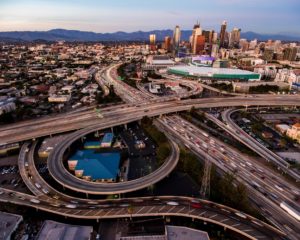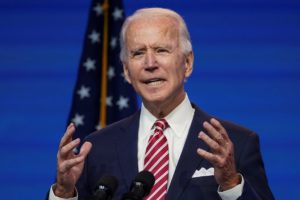Apr
25
Infrastructure
“It’s called infrastructure, but inside the Trojan horse it’s going to be more borrowed money, and massive tax increases on all the productive parts of our economy.” — Senate Minority Leader Mitch McConnell
As I am sure you are aware, the Biden administration working with the Democrats in Congress have proposed a huge “infrastructure” bill — roughly $2.25 trillion worth. It’s a monstrosity, and a controversial one, to say the least.

In the past, an “infrastructure” bill would be focused on roads/highways or bridges (or maybe ports) or some combination thereof, which usually gets strong bipartisan support. This one, however, is a cross between the recent $1.9 trillion COVID-19 package (less than 10% of which was health-related) and the Green New Deal (which is a smorgasbord of funding for pie-in-the-sky “green” initiatives), wrapped up in economy-shrinking regulations and tax hikes and giving big-government even more control.
What we mean by “infrastructure” here is public infrastructure — i.e., those systems, services, structures, and facilities owned and operated by the government for use by the general public to enhance living standards and help the overall flow of the economy. There are different subsets of these systems and services, but in addition to the aformentioned roads & highways, bridges, ports, they typically include various utilities (e.g., water, sewer, gas, electric), telecommunications and network services (and a good case can now be made for broadband), as well as public parks, government buildings, etc.
The current bill being touted by Democrats as an “infrastructure bill” allocates less than 6% ($115 billion) for roads and bridges, which has caused a lot of people (mostly not Democrats, of course) to call them out on this. To be fair, it also allocates $42 billion for waterways, locks, dams, ports, and airports, and another $80 billion each for railroads and public transportation. Add in $100 billion to expand broadband service. But, even if we accept those, that is still only ~18% for actual infrastructure.
What else do they want to pay for in this “infrastructure” bill? Here are a few examples, according to a tweet from Rep. Gary Palmer (R-AL):
-$400 billion for expansion of Medicaid
-$213 billion for housing and to increase federal control of local housing markets
-$100 billion of additional funding for schools without requiring them to reopen
-$50 billion for a new office at the U.S. Department of Commerce
-$35 billion for climate science, innovation, and R&D
-$10 billion for a new “Civilian Climate Corps”
-Overturns right-to-work laws in 27 states
Even the incredibly inefficient electric vehicle (EV) industry will get a $174 billion cut. This, despite many years of tax breaks and incentives. But, of course, it’s “green”. Same thinking goes for more federal subsidies of the impractical moneypit that falls under “transit and Amtrak”, which would receive $165 million.

Then, we have Sen. Kirsten Gillibrand (D-NY) tweeting out: “Paid leave is infrastructure. Child care is infrastructure. Caregiving is infrastructure.” Wrong, Senator, they aren’t. And it isn’t just the people on the right (e.g., Ben Shapiro, Sen. Ted Cruz, Gov. Kristi Noem) who are balking at this. Democrat commentator Keith Olbermann tweeted this response:
“No, Senator.
These are all vital needs. I would argue they are as important as nuts and bolts and grids and networks.
But when you drain a word of it’s [sic] meaning, you damage its impact, your cause, and the value of language.”
Gotta agree with Olbermann there.
So, let’s jump back to those things that I listed as legit infrastructure. Should those be in this infrastructure “omnibus”? In some cases, maybe. The issue is whether or not the federal government is the best entity to either run or fund such things. (And, make no mistake, if a state or municipality takes federal funds to build, maintain, or upgrade, then the federal government has their hooks in.) When the federal government is involved, there is the infamous federal bureaucracy and regulation hoops to deal with. Do you really think some U.S. Congresspersons or federal bureaucrats are the best choices to decide what your state or city needs and how to do it? Besides, many of these industries (e.g., utilities, telecoms, freight railroads) are already doing quite well and making a profit as private ventures and partnerships between local public and private entities.
Then there is the matter of how Biden and the Dems plan to pay for all of their largesse. If you guessed — or remembered what I mentioned earlier — that it will be via heavy taxation and adding to the national debt, you would be correct. This will have all sorts of economy-stifling effects. Consider this from Townhall’s Veronique de Rugy:
“The Tax Foundation estimates that Biden’s tax increases would reduce investment in fixed assets by more than $1 trillion. That means fewer infrastructure investments, too. This is unfortunate since a 2016 Congressional Budget Office report finds that private sector investments deliver twice the economic returns of federal investments. But as Edwards notes, ‘Biden’s proposed green and labor union regulations would further undermine infrastructure investment.'”

Consider also this bit from Heritage’s David Ditch:
“Although President Joe Biden is promoting the plan as a way to create jobs through infrastructure projects, its combination of tax hikes and central planning would leave the nation poorer and more dysfunctional.”
In short, Biden and the Dems are doubling down yet again, ignoring evidence from past and current failures that their big government, tax-and-spend approach does not help people. What it does do is make more people, businesses, and local governments more dependent on the federal government. This is just a huge power grab, as the “progressives” pull us over the cliff into Leftist totalitarianism.
If you only read three articles on this subject, I recommend these two by David Ditch and the third by Veronique de Rugy:
“Biden’s Tax-and-Spend ‘Infrastructure’ Plan Would Slow Economy, Deepen Swamp”
“9 Things You Need to Know About Biden’s ‘Infrastructure’ Spending Plan”
“Biden’s Crony Anti-Infrastructure Plan”















